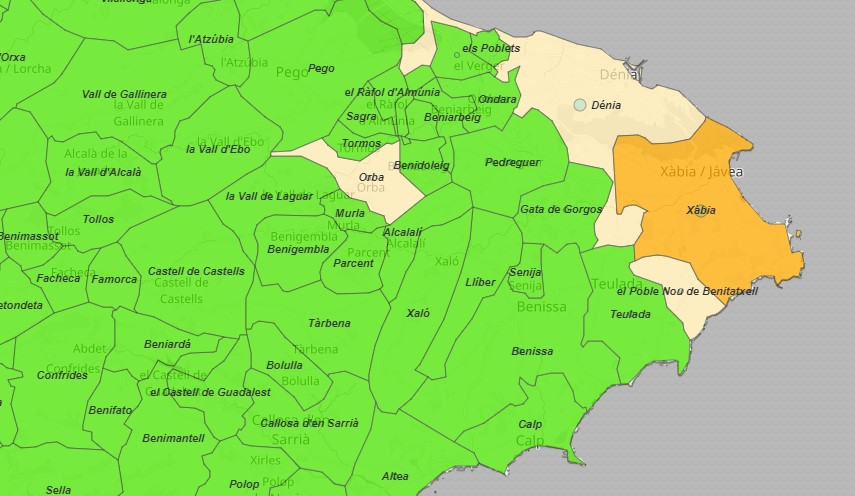VIRUS UPDATE: Positive cases in Xàbia reach 1,500 since pandemic began
The 14-day IA rate has risen to 103.51 which means that Xàbia is the only municipality at medium risk level in the Marina Alta.

Friday 4th June 2021 – Compiled by MIKE SMITH
The total number of positive coronavirus cases detected by PCR test in Xàbia has risen by 10 to 1,500, according to the latest update from the regional health ministry. And with 29 cases detected in the past 14 days, the municipality’s 14-day IA rate, a measure of the speed at which the virus moves through the population, has risen again to 103.51 cases per 100,000 inhabitants, the highest it has been since February 24th, which means that the town remains in the ‘Medium Risk’ category, the only municipality in the Marina Alta to find itself at that level. Some good new is that there have been no new deaths in Xàbia since late March and the number for remains at 12.
In the Marina Alta region, there have been 56 new positive cases detected in the past 14 days (of which Xàbia accounts for more than half) whilst the total number of positive cases since the pandemic began has been confirmed as 10,137 since the last update, a rise of 18; Xàbia accounts for 10 of them, Calp 4 and one each in Dénia, El Vergel, Pedreguer and Xaló. The region’s 14-day IA rate has risen slightly to to 32.82 cases per 100,000 inhabitants and the region remains in the ‘Low Risk’ category. There have been no new deaths since the last update and the region’s toll remains 203.
With an IA-rate of 103.51, Xàbia is the only municipality in the Marina Alta at the ‘Medium Risk’ level. Four municipalities are in the ‘Low Risk’ category: El Poble Nou de Benitatxell (44.92), Orba (44.80), Dénia (28.02), El Vergel (21.24). The rest of the municipalities in the region are at the ‘New Normal’ level, with 21 of them – mostly in the inland valleys – showing no infection spread over the last 14 days.
Spain
Spain’s 14-day IA rate is 118.29 cases per 100,000 inhabitants and the country remains in the ‘Medium Risk’ category. The rate has dropped by around 15% in the past two weeks, whilst the Positivity Rate, the measure of how many coronavirus tests return positive, is 4.86%; a value of 5% or less indicates that transmission of the virus is more or less under control.
Across the autonomous regions, La Rioja is now the only one with a 14-day IA rate above 200 (207.24) where infection spread has risen by 41% over the past fortnight. Five regions remain at ‘High Risk’: La Rioja, País Vasco, Andalucia, Melilla and Madrid. The autonomous city Ceuta (30.88) remains the region with the lowest infection rate in Spain whilst the Comunidad Valenciana (34.70) remains at the ‘Low Risk’ level, although the infection rate has been rising slowly over the past week and the region now finds itself at similar levels to the first half of May.
Infection spread has continued dropped in the majority of Spain’s autonomous regions and enclaves but the rate of decrease has been slowing down.
The newspaper El País has reported that, subject to official confirmation on the Official State Gazette (BOE), from next Monday, people who have been vaccinated against COVID-19 will be able to enter Spain, regardless of where they have traveled from. However, the UK has opted to keep all EU countries on its amber lists for travel, a blow for the tourism industry, which means the holidaymakers returning from Spain must take a PCR test before travel, quarantine for 10 days after arrival in the UK, and take two home coronavirus tests.
Vaccination (03.06.21)
Spain has administered 28,182,345 doses of vaccine, which is 93.5% of those which it has already received. A total of 9,979,204 people have completed the recommended course, which is 24.9% of the total of the population which is to be vaccinated (40,129,822).
According to the latest data provided by the health authorities, 84.7% of people aged 50 and over in Spain have received at least one dose, with 45.5% having completed the recommended course.
The Comunidad Valenciana has administered 2,840,184 doses of vaccine, which is 93.0% of the total which it has received. A total of 1,012,909 people have completed the recommended course, which 23.7% of the population which is to be vaccinated (4,289,305).
According to the latest data provided by the health authorities, 81.1% of people aged 50 and over in the Comunidad Valenciana have received at least one dose, with 45.3% having completed the recommended course.
The newspaper El Pais has reported that the Public Health Commision has decided that the single-dose Janssen vaccine will be administered to 40-49 age group, which would see the speed of the vaccination campaign accelerate. Safety fears have been based on data from the United States where nine blood clot cases have been reported from 10 million administered shots – less than one in a million. Spain is due to take delivery of 17.5 million doses.
LINKS
- Actualización nº 389. Enfermedad por el coronavirus (COVID-19). 03.06.2021
- GIV COVID-19 Gestión integral de la vacunación COVID-19
- COVID-19 C. Valenciana: Monitoratge de la situació



